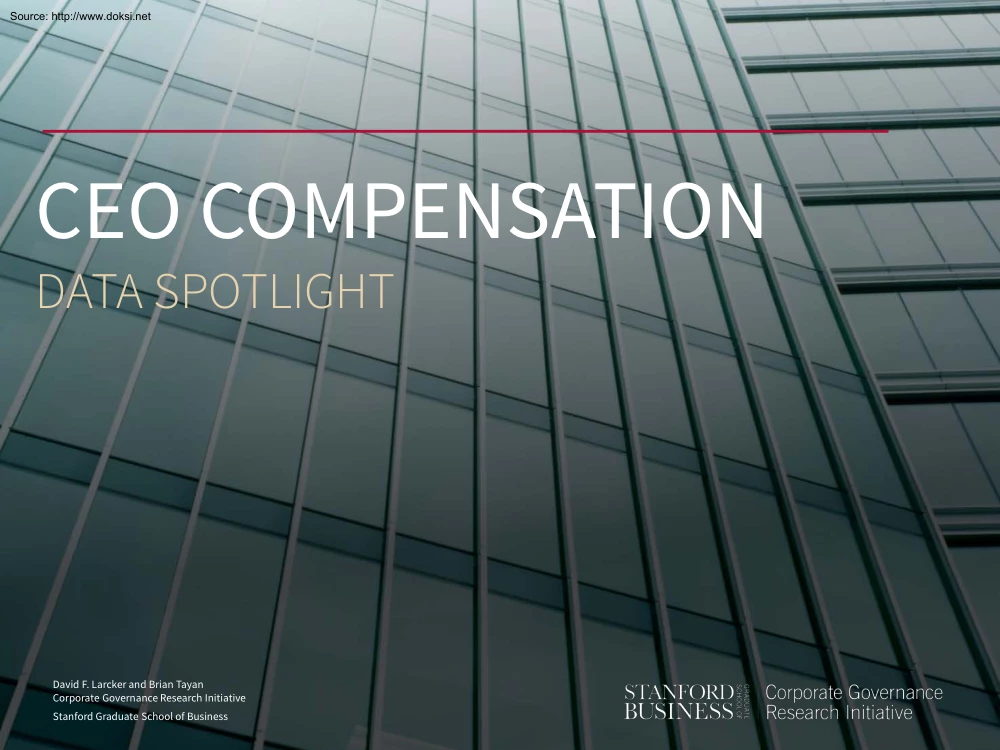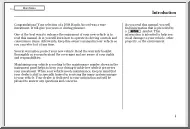Please log in to read this in our online viewer!

Please log in to read this in our online viewer!
No comments yet. You can be the first!
What did others read after this?
Content extract
Source: http://www.doksinet CEO COMPENSATION DATA SPOTLIGHT David F. Larcker and Brian Tayan Corporate Governance Research Initiative Stanford Graduate School of Business Source: http://www.doksinet COMPENSATION LEVELS The typical CEO of an S&P 500 company receives approximately $10 million in annual compensation. Median values. Sample includes CEO compensation of companies listed in the S&P 500 Index Source: Equilar, CEO Pay Trends (2018); Murphy (2012) Source: http://www.doksinet COMPENSATION BY FIRM SIZE In general, CEO compensation levels vary with company size. Firm Size Total Expected Compensation Market Value ($ in Thousands) Top 100 $13,713,000 $104,413,000 101 to 500 $10,656,000 $21,710,000 501 to 1,000 $6,458,000 $6,086,000 1,001 to 2,000 $3,981,000 $2,016,000 2,001 to 3,000 $2,092,000 $624,000 3,001 to 4,000 $900,000 $144,000 $2,869,000 $1,143,000 1 to 4,000 Median values. Sample includes largest 4,000 US companies included in the
Equilar compensation database, fiscal years ending June 2013 to May 2014. Source: Data from Equilar; calculations by the authors. Source: http://www.doksinet COMPENSATION LEVELS “Average” compensation levels also vary depending on methodology (average vs. median, expected pay vs realized pay) Based on Average Values Based on Median Values Based on 2011 data. Sample includes CEO compensation of companies listed in the S&P 500 Index Source: Murphy (2012) Source: http://www.doksinet COMPENSATION LEVELS Still, compensation levels have risen considerably in recent decades, driven in large part by equity-based awards. Sample includes average CEO compensation of the largest firms in 1940, 1960, and 1990, inflation-adjusted in 2000 dollars. Source: Friedman and Jenter (2010) Source: http://www.doksinet INTERNATIONAL COMPENSATION CEO compensation is higher in the U.S than other countries, after controlling for firm size and industry. Based on 2006 data. Estimated total CEO
pay for hypothetical company with $1 billion in sales, controlling for industry Source: Fernandes, Ferreira, Matos, and Murphy (2012) Source: http://www.doksinet INTERNATIONAL COMPENSATION U.S “pay premium” is driven largely by equity-based awards Based on 2006 data. Estimated total CEO pay for hypothetical company with $1 billion in sales, controlling for industry Source: Fernandes, Ferreira, Matos, and Murphy (2012) Source: http://www.doksinet RATIO OF CEO TO NEO PAY CEOs receive approximately three times the compensation of other named executive officers (NEOs) in the company. The ratio has been stable in recent years Based on median values. Sample includes CEO and named executive officer (NEO) compensation of companies listed in the S&P 500 Index. Source: Equilar, Executive Compensation and Governance Outlook (2017) Source: http://www.doksinet RATIO OF CEO TO AVERAGE WORKER PAY CEOs receive considerably more pay than the average worker. The ratio depends heavily
on the skill set and geographic location of employee base. Sample includes 1700 companies in fiscal year 2018. Note: companies with large ratio report employing a significant portion of their employee base in low-wage countries. Source: Data provided by Equilar. Calculations by the authors Source: http://www.doksinet RATIO OF CEO TO AVERAGE WORKER PAY It also varies by company size and industry. Revenue sample includes companies in Russell 3000. Industry sample includes 1700 companies Fiscal year 2018 Source: Semler Brossy (2018), and data provided by Equilar. Source: http://www.doksinet SAY ON PAY Despite the controversy over pay levels, shareholders generally vote to approve CEO compensation plans as part of the annual non-binding “say on pay” process. Sample includes voting results for companies in the Russell 3000 Index. Source: Semler Brossy (2018) Source: http://www.doksinet CEO COMPENSATION MIX CEO compensation packages are dominated by incentive-based pay
(bonus, stock, and options) whose ultimate value depends on performance. Sample includes CEO compensation of companies listed in the S&P 500 Index. Source: Equilar, CEO Pay Trends (2017) Source: http://www.doksinet TYPICAL BONUS PLAN A typical bonus plan offers a range of payouts (lower threshold, target amount, upper threshold). “Incentive Zone” Bonus Cap Target Bonus Hurdle Bonus Lower Threshold Source: Murphy (2012) Target Threshold Upper Threshold Source: http://www.doksinet EQUITY AWARD PAYOUTS Equity awards tie CEO compensation to stock price. Stock awards change 1-for-1 with stock price. Options add “convexity” by magnifying both upside and downside value The authors Source: http://www.doksinet EQUITY AWARDS BY GRANT PREVALENCE In recent years, stock-based performance awards have replaced stock options as the most prevalent form of equity-based pay. Sample includes CEO compensation of companies listed in the S&P 500 Index. Source: Equilar, CEO
Pay Trends (2018) Source: http://www.doksinet PREVALENCE OF PERFORMANCE METRICS The ultimate value of stock-based performance awards depends on a mix of stockprice and operating performance metrics. Percentage of companies using these metrics in long-term incentive programs (LTIPs). Sample includes CEO compensation of companies listed in the S&P 500 Index. Source: Equilar, Executive Long-Term Incentive Plans (2018) Source: http://www.doksinet STOCK OWNERSHIP GUIDELINES CEOs are generally required to hold company stock. This value is usually calculated as a multiple of the CEO’s annual salary. Ownership Guidelines Multiple of base salary 84% Fixed number of shares 8% Other 8% Median value $9 million Sample includes CEOs of companies in the Fortune 100. Source: Equilar, Stock Ownership Guidelines (2016) Source: http://www.doksinet CEO WEALTH The typical CEO holds a significant amount of equity (stock and options) in the company. The value of this wealth varies
considerably with stock price changes Change in Wealth Firm Size CEO Wealth 1% Stock Change 50% Stock Change 100% Stock Change Top 100 $104,912,000 $1,556,000 $85,535,000 $176,985,000 101 to 500 $59,922,000 $922,000 $47,470,000 $95,549,000 501 to 1,000 $34,337,000 $486,000 $25,500,000 $52,131,000 1,001 to 2,000 $22,300,000 $310,000 $16,645,000 $33,390,000 2,001 to 3,000 $10,445,000 $135,000 $6,923,000 $14,235,000 3,001 to 4,000 $3,470,000 $43,000 $2,218,000 $4,534,000 1 to 4,000 $14,946,000 $193,000 $9,907,000 $20,332,000 Median values. Sample includes largest 4,000 US companies included in the Equilar compensation database, fiscal years ending June 2013 to May 2014 Includes stock options, restricted stock, performance plans, and direct stock ownership. Excludes personal wealth outside company stock Does not take into account potential equity hedges. Source: Data from Equilar; calculations by the authors. Source: http://www.doksinet CEO HEDGING
ACTIVITY Many CEOs hedge a portion of these equity holdings. Sample includes 2,042 hedge transactions, 929 individuals, 582 companies, 1996-2006. Median values reflect the dollar amount of equity ownership that is hedged. Source: Bettis, Bizjak, and Kalpathy (2015) Source: http://www.doksinet IMPACT OF HEDGING ON CEO WEALTH Hedges significantly limit an executive’s exposure to changes in stock price and significantly alter the incentives of equity ownership. The authors Source: http://www.doksinet TRENDS IN EXECUTIVE PAY • The size and structure of CEO compensation is influenced by a mix of market forces, tax, and regulatory changes. • Significant milestones impacting CEO compensation include: – Securities Exchange Act of 1934 – Revenue Acts of 1950, 1954 – Revenue Act of 1964 – Price controls in 1970s – Budget Reconciliation Act of 1993 – Sarbanes Oxley Act of 2002 – Dodd Frank Act of 2010 • These are summarized in the following pages Source:
http://www.doksinet HISTORICAL MILESTONES IN EXECUTIVE PAY Year Event 1934 Securities and Exchange Act of 1934 1950 • Requires companies to disclose compensation of officers and directors. • Requires executives to hold shares from exercised options and performance-plans six months before sale (“short-swing sale”). 1964 • Executive compensation among public companies becomes public information. • Stock option plans increase in prevalence. Revenue Act of 1950 • 1954 Impact Creates “restricted stock options” taxable upon sale (rather than exercise) and at capital gains rate. Revenue Act of 1954 • Allows companies to lower exercise price of previously granted • restricted options. • Limits exercise term to 10 years. Further increases the attractiveness of stock options as a form of compensation. Revenue Act of 1964 • Creates “qualified stock options” to replace restricted options. • Requires executives to hold qualified options
three years to qualify for capital gains rate. • Prevents companies from lowering exercise price of previously granted options. • Limits exercise term to 5 years. • Lowers income tax rate. • Reduces the attractiveness of restricted (“qualified”) stock options. Source: http://www.doksinet HISTORICAL MILESTONES IN EXECUTIVE PAY Year 1969 1971 1972 1976 Event Impact Tax Reform Act of 1969 • Qualified stock options are made subject to Alternate Minimum • Tax . Qualified stock options become virtually nonexistent. • • Lowers income tax rate and increases capital gains rate. Companies begin to issue “non-qualified stock options,” taxable at income tax rates and deductible to the company. • Increases the prevalence of performance-based plans and non-qualified stock options . • Companies provide more perquisites. • Increases the favorability of time-vested stock options. Nixon wage-and-price controls • Limits executive pay increases
to 5.5% • Limits do not apply to performance-based bonus plans and non-qualified stock option plans approved by shareholders. • Limits do not apply to benefits and perquisites, such as lowinterest loans, club memberships, yachts, limos, and jets. APB Opinion No. 25 • No accounting expense required for time-vested stock options if exercise price equals stock price on the grant date. • Requires accounting expense for performance-based stock options. Revenue Act of 1976 • Bans qualified stock options SEC Release No. 34-13097 • Exempts stock appreciation rights (SARs) from short-swing sale • rule of the Exchange Act of 1934. Stock appreciation rights increase in prevalence. Source: http://www.doksinet HISTORICAL MILESTONES IN EXECUTIVE PAY Year 1977 Event SEC Interpretive Release #5856 • 1981 1991 1992 Requires companies to disclose value of perquisites in company proxy. Economic Recovery Act of 1981 • 1984 Impact Creates “incentive stock
options” (ISO), a new form of qualified stock option limited to $100,000 per executive per year. • ISOs begin to be issued to middle-level managers. Deficit Reduction Act of 1984 • Limits deductibility of change-in-control (“golden parachute”) payments that exceed three times base compensation. • Golden parachute payments increase in prevalence. • Imposes 20% excise tax on golden parachute payments that exceed three times base, payable by the executive. • Companies offer tax gross-ups to compensate executives for any excise taxes owed. SEC Release No. 34-28869 • Changes the start date of the six-month holding period for stock options to the grant date (from the exercise date). • Increases the attractiveness of stock options to an executive. • Stock options become immediately sellable after vesting. • Stock options increase in prevalence, replacing stock appreciation rights. SEC Release No. 34-31327 • Expands disclosure requirements for
executive compensation. • Requires disclosure of all components of compensation to the CEO and four named executive officers for the previous three years in a Summary Compensation Table. Requires disclosure of the number (but not the value) of stock options. • Source: http://www.doksinet HISTORICAL MILESTONES IN EXECUTIVE PAY Year 1993 1995 2002 Event Impact Omnibus Budget Reconciliation Act of 1993 • Limits tax deductibility of executive compensation above $1 million. • Increases attractiveness of stock options to a company. • Limit applies to time-vested restricted stock. • Limit does not apply to performance-based compensation, including stock options. • Applies only to public companies. • Requires companies to disclose the value of stock option grants • in footnotes to financial statements. Stock options continue to receive favorable accounting treatment. • Recommends but does not require the expensing of stock options. FAS 123 The
Sarbanes-Oxley Act of 2002 • Requires executives to disclose new equity grants within two business days of grant. • Eliminates practice of cashless exercise of stock options. • Prohibits personal loans to officers and directors. • Eliminates practice of stock option backdating. • Requires companies to clawback incentive compensation in the case of financial restatement resulting from fraud or misconduct. Source: http://www.doksinet HISTORICAL MILESTONES IN EXECUTIVE PAY Year 2004 Event Impact Requires companies to expense stock options based on fair • value on the grant date. Stock options no longer receive favorable • accounting treatment relative to restricted stock or performance-units. FAS 123R Restricted stock grants and performance units • increase in prevalence. 2006 SEC Release No. 34-55009 Requires disclosure of the value of stock option grants in • Summary Compensation Table. 2010 The Dodd-Frank Act of 2010 Grants shareholders an
advisory vote on executive • compensation (“say on pay”). 2017 Further decreases the attractiveness of stock • options. • Requires more stringent clawback policies. • Requires disclosure of the ratio of CEO-to-average-worker pay. • Requires disclosure of executive hedging policy. • No discernable impact on pay levels. Tax Cuts and Jobs Act Eliminates provisions that allowed for the tax deductibility of • performance-based executive compensation above $1 million. Source: Adapted from Wells (2010); Murphy (2012) Decreases the attractiveness of performance• based pay to a company. Source: http://www.doksinet BIBLIOGRAPHY Carr Bettis, John Bizjak, and Swaminathan Kalpathy. Why Do Insiders Hedge Their Ownership? An Empirical Examination 2015 Equilar. CEO Pay Trends 2014-2018 Equilar. Executive Compensation & Governance Outlook 2016-2017 Equilar. Executive Long-Term Incentive Plans: Pay for Performance Trends 2018 Equilar. Stock Ownership Guidelines
2016 Nuno Fernandes, Miguel A. Ferreira, Pedro Matos, and Kevin J Murphy Are US CEOs Paid More? New International Evidence 2012 Carola Frydman and Dirk Jenter. CEO Compensation Social Science Research Network 2010 Kevin J. Murphy Executive Compensation: Where We Are, and How We Got Here Handbook of the Economics of Finance 2012 Semler Brossy. Say on Pay and Proxy Results October 4, 2018 Harwell Wells. “No Man Can Be Worth $1,000,000 a Year”: The Fight Over Executive Compensation in 1930s America University of Richmond Law Review (2010)
Equilar compensation database, fiscal years ending June 2013 to May 2014. Source: Data from Equilar; calculations by the authors. Source: http://www.doksinet COMPENSATION LEVELS “Average” compensation levels also vary depending on methodology (average vs. median, expected pay vs realized pay) Based on Average Values Based on Median Values Based on 2011 data. Sample includes CEO compensation of companies listed in the S&P 500 Index Source: Murphy (2012) Source: http://www.doksinet COMPENSATION LEVELS Still, compensation levels have risen considerably in recent decades, driven in large part by equity-based awards. Sample includes average CEO compensation of the largest firms in 1940, 1960, and 1990, inflation-adjusted in 2000 dollars. Source: Friedman and Jenter (2010) Source: http://www.doksinet INTERNATIONAL COMPENSATION CEO compensation is higher in the U.S than other countries, after controlling for firm size and industry. Based on 2006 data. Estimated total CEO
pay for hypothetical company with $1 billion in sales, controlling for industry Source: Fernandes, Ferreira, Matos, and Murphy (2012) Source: http://www.doksinet INTERNATIONAL COMPENSATION U.S “pay premium” is driven largely by equity-based awards Based on 2006 data. Estimated total CEO pay for hypothetical company with $1 billion in sales, controlling for industry Source: Fernandes, Ferreira, Matos, and Murphy (2012) Source: http://www.doksinet RATIO OF CEO TO NEO PAY CEOs receive approximately three times the compensation of other named executive officers (NEOs) in the company. The ratio has been stable in recent years Based on median values. Sample includes CEO and named executive officer (NEO) compensation of companies listed in the S&P 500 Index. Source: Equilar, Executive Compensation and Governance Outlook (2017) Source: http://www.doksinet RATIO OF CEO TO AVERAGE WORKER PAY CEOs receive considerably more pay than the average worker. The ratio depends heavily
on the skill set and geographic location of employee base. Sample includes 1700 companies in fiscal year 2018. Note: companies with large ratio report employing a significant portion of their employee base in low-wage countries. Source: Data provided by Equilar. Calculations by the authors Source: http://www.doksinet RATIO OF CEO TO AVERAGE WORKER PAY It also varies by company size and industry. Revenue sample includes companies in Russell 3000. Industry sample includes 1700 companies Fiscal year 2018 Source: Semler Brossy (2018), and data provided by Equilar. Source: http://www.doksinet SAY ON PAY Despite the controversy over pay levels, shareholders generally vote to approve CEO compensation plans as part of the annual non-binding “say on pay” process. Sample includes voting results for companies in the Russell 3000 Index. Source: Semler Brossy (2018) Source: http://www.doksinet CEO COMPENSATION MIX CEO compensation packages are dominated by incentive-based pay
(bonus, stock, and options) whose ultimate value depends on performance. Sample includes CEO compensation of companies listed in the S&P 500 Index. Source: Equilar, CEO Pay Trends (2017) Source: http://www.doksinet TYPICAL BONUS PLAN A typical bonus plan offers a range of payouts (lower threshold, target amount, upper threshold). “Incentive Zone” Bonus Cap Target Bonus Hurdle Bonus Lower Threshold Source: Murphy (2012) Target Threshold Upper Threshold Source: http://www.doksinet EQUITY AWARD PAYOUTS Equity awards tie CEO compensation to stock price. Stock awards change 1-for-1 with stock price. Options add “convexity” by magnifying both upside and downside value The authors Source: http://www.doksinet EQUITY AWARDS BY GRANT PREVALENCE In recent years, stock-based performance awards have replaced stock options as the most prevalent form of equity-based pay. Sample includes CEO compensation of companies listed in the S&P 500 Index. Source: Equilar, CEO
Pay Trends (2018) Source: http://www.doksinet PREVALENCE OF PERFORMANCE METRICS The ultimate value of stock-based performance awards depends on a mix of stockprice and operating performance metrics. Percentage of companies using these metrics in long-term incentive programs (LTIPs). Sample includes CEO compensation of companies listed in the S&P 500 Index. Source: Equilar, Executive Long-Term Incentive Plans (2018) Source: http://www.doksinet STOCK OWNERSHIP GUIDELINES CEOs are generally required to hold company stock. This value is usually calculated as a multiple of the CEO’s annual salary. Ownership Guidelines Multiple of base salary 84% Fixed number of shares 8% Other 8% Median value $9 million Sample includes CEOs of companies in the Fortune 100. Source: Equilar, Stock Ownership Guidelines (2016) Source: http://www.doksinet CEO WEALTH The typical CEO holds a significant amount of equity (stock and options) in the company. The value of this wealth varies
considerably with stock price changes Change in Wealth Firm Size CEO Wealth 1% Stock Change 50% Stock Change 100% Stock Change Top 100 $104,912,000 $1,556,000 $85,535,000 $176,985,000 101 to 500 $59,922,000 $922,000 $47,470,000 $95,549,000 501 to 1,000 $34,337,000 $486,000 $25,500,000 $52,131,000 1,001 to 2,000 $22,300,000 $310,000 $16,645,000 $33,390,000 2,001 to 3,000 $10,445,000 $135,000 $6,923,000 $14,235,000 3,001 to 4,000 $3,470,000 $43,000 $2,218,000 $4,534,000 1 to 4,000 $14,946,000 $193,000 $9,907,000 $20,332,000 Median values. Sample includes largest 4,000 US companies included in the Equilar compensation database, fiscal years ending June 2013 to May 2014 Includes stock options, restricted stock, performance plans, and direct stock ownership. Excludes personal wealth outside company stock Does not take into account potential equity hedges. Source: Data from Equilar; calculations by the authors. Source: http://www.doksinet CEO HEDGING
ACTIVITY Many CEOs hedge a portion of these equity holdings. Sample includes 2,042 hedge transactions, 929 individuals, 582 companies, 1996-2006. Median values reflect the dollar amount of equity ownership that is hedged. Source: Bettis, Bizjak, and Kalpathy (2015) Source: http://www.doksinet IMPACT OF HEDGING ON CEO WEALTH Hedges significantly limit an executive’s exposure to changes in stock price and significantly alter the incentives of equity ownership. The authors Source: http://www.doksinet TRENDS IN EXECUTIVE PAY • The size and structure of CEO compensation is influenced by a mix of market forces, tax, and regulatory changes. • Significant milestones impacting CEO compensation include: – Securities Exchange Act of 1934 – Revenue Acts of 1950, 1954 – Revenue Act of 1964 – Price controls in 1970s – Budget Reconciliation Act of 1993 – Sarbanes Oxley Act of 2002 – Dodd Frank Act of 2010 • These are summarized in the following pages Source:
http://www.doksinet HISTORICAL MILESTONES IN EXECUTIVE PAY Year Event 1934 Securities and Exchange Act of 1934 1950 • Requires companies to disclose compensation of officers and directors. • Requires executives to hold shares from exercised options and performance-plans six months before sale (“short-swing sale”). 1964 • Executive compensation among public companies becomes public information. • Stock option plans increase in prevalence. Revenue Act of 1950 • 1954 Impact Creates “restricted stock options” taxable upon sale (rather than exercise) and at capital gains rate. Revenue Act of 1954 • Allows companies to lower exercise price of previously granted • restricted options. • Limits exercise term to 10 years. Further increases the attractiveness of stock options as a form of compensation. Revenue Act of 1964 • Creates “qualified stock options” to replace restricted options. • Requires executives to hold qualified options
three years to qualify for capital gains rate. • Prevents companies from lowering exercise price of previously granted options. • Limits exercise term to 5 years. • Lowers income tax rate. • Reduces the attractiveness of restricted (“qualified”) stock options. Source: http://www.doksinet HISTORICAL MILESTONES IN EXECUTIVE PAY Year 1969 1971 1972 1976 Event Impact Tax Reform Act of 1969 • Qualified stock options are made subject to Alternate Minimum • Tax . Qualified stock options become virtually nonexistent. • • Lowers income tax rate and increases capital gains rate. Companies begin to issue “non-qualified stock options,” taxable at income tax rates and deductible to the company. • Increases the prevalence of performance-based plans and non-qualified stock options . • Companies provide more perquisites. • Increases the favorability of time-vested stock options. Nixon wage-and-price controls • Limits executive pay increases
to 5.5% • Limits do not apply to performance-based bonus plans and non-qualified stock option plans approved by shareholders. • Limits do not apply to benefits and perquisites, such as lowinterest loans, club memberships, yachts, limos, and jets. APB Opinion No. 25 • No accounting expense required for time-vested stock options if exercise price equals stock price on the grant date. • Requires accounting expense for performance-based stock options. Revenue Act of 1976 • Bans qualified stock options SEC Release No. 34-13097 • Exempts stock appreciation rights (SARs) from short-swing sale • rule of the Exchange Act of 1934. Stock appreciation rights increase in prevalence. Source: http://www.doksinet HISTORICAL MILESTONES IN EXECUTIVE PAY Year 1977 Event SEC Interpretive Release #5856 • 1981 1991 1992 Requires companies to disclose value of perquisites in company proxy. Economic Recovery Act of 1981 • 1984 Impact Creates “incentive stock
options” (ISO), a new form of qualified stock option limited to $100,000 per executive per year. • ISOs begin to be issued to middle-level managers. Deficit Reduction Act of 1984 • Limits deductibility of change-in-control (“golden parachute”) payments that exceed three times base compensation. • Golden parachute payments increase in prevalence. • Imposes 20% excise tax on golden parachute payments that exceed three times base, payable by the executive. • Companies offer tax gross-ups to compensate executives for any excise taxes owed. SEC Release No. 34-28869 • Changes the start date of the six-month holding period for stock options to the grant date (from the exercise date). • Increases the attractiveness of stock options to an executive. • Stock options become immediately sellable after vesting. • Stock options increase in prevalence, replacing stock appreciation rights. SEC Release No. 34-31327 • Expands disclosure requirements for
executive compensation. • Requires disclosure of all components of compensation to the CEO and four named executive officers for the previous three years in a Summary Compensation Table. Requires disclosure of the number (but not the value) of stock options. • Source: http://www.doksinet HISTORICAL MILESTONES IN EXECUTIVE PAY Year 1993 1995 2002 Event Impact Omnibus Budget Reconciliation Act of 1993 • Limits tax deductibility of executive compensation above $1 million. • Increases attractiveness of stock options to a company. • Limit applies to time-vested restricted stock. • Limit does not apply to performance-based compensation, including stock options. • Applies only to public companies. • Requires companies to disclose the value of stock option grants • in footnotes to financial statements. Stock options continue to receive favorable accounting treatment. • Recommends but does not require the expensing of stock options. FAS 123 The
Sarbanes-Oxley Act of 2002 • Requires executives to disclose new equity grants within two business days of grant. • Eliminates practice of cashless exercise of stock options. • Prohibits personal loans to officers and directors. • Eliminates practice of stock option backdating. • Requires companies to clawback incentive compensation in the case of financial restatement resulting from fraud or misconduct. Source: http://www.doksinet HISTORICAL MILESTONES IN EXECUTIVE PAY Year 2004 Event Impact Requires companies to expense stock options based on fair • value on the grant date. Stock options no longer receive favorable • accounting treatment relative to restricted stock or performance-units. FAS 123R Restricted stock grants and performance units • increase in prevalence. 2006 SEC Release No. 34-55009 Requires disclosure of the value of stock option grants in • Summary Compensation Table. 2010 The Dodd-Frank Act of 2010 Grants shareholders an
advisory vote on executive • compensation (“say on pay”). 2017 Further decreases the attractiveness of stock • options. • Requires more stringent clawback policies. • Requires disclosure of the ratio of CEO-to-average-worker pay. • Requires disclosure of executive hedging policy. • No discernable impact on pay levels. Tax Cuts and Jobs Act Eliminates provisions that allowed for the tax deductibility of • performance-based executive compensation above $1 million. Source: Adapted from Wells (2010); Murphy (2012) Decreases the attractiveness of performance• based pay to a company. Source: http://www.doksinet BIBLIOGRAPHY Carr Bettis, John Bizjak, and Swaminathan Kalpathy. Why Do Insiders Hedge Their Ownership? An Empirical Examination 2015 Equilar. CEO Pay Trends 2014-2018 Equilar. Executive Compensation & Governance Outlook 2016-2017 Equilar. Executive Long-Term Incentive Plans: Pay for Performance Trends 2018 Equilar. Stock Ownership Guidelines
2016 Nuno Fernandes, Miguel A. Ferreira, Pedro Matos, and Kevin J Murphy Are US CEOs Paid More? New International Evidence 2012 Carola Frydman and Dirk Jenter. CEO Compensation Social Science Research Network 2010 Kevin J. Murphy Executive Compensation: Where We Are, and How We Got Here Handbook of the Economics of Finance 2012 Semler Brossy. Say on Pay and Proxy Results October 4, 2018 Harwell Wells. “No Man Can Be Worth $1,000,000 a Year”: The Fight Over Executive Compensation in 1930s America University of Richmond Law Review (2010)




 Just like you draw up a plan when you’re going to war, building a house, or even going on vacation, you need to draw up a plan for your business. This tutorial will help you to clearly see where you are and make it possible to understand where you’re going.
Just like you draw up a plan when you’re going to war, building a house, or even going on vacation, you need to draw up a plan for your business. This tutorial will help you to clearly see where you are and make it possible to understand where you’re going.